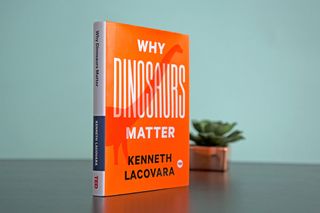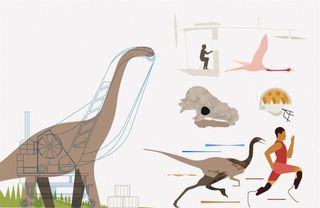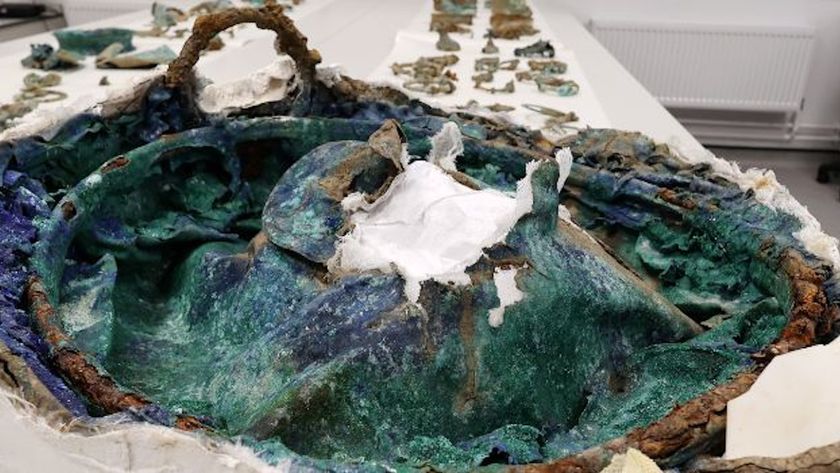How a Boy Who Was Obsessed with Dinosaurs Discovered Dreadnoughtus
At the age of 7, Kenneth Lacovara pored through a box full of rocks and fossils at a Boy Scout meeting. He was intrigued by the fossils' shapes and colors. And "the animals trapped in stone" reminded him of the fern fossils and quartz crystals his brother had unearthed at their uncle's dairy farm in Pennsylvania.
Lacovara was captivated. His enthusiasm for fossils led to him study geology and become a paleontologist who travels the world searching for dinosaur fossils. That hard work paid off. In 2005, he discovered the remains of a colossal, long-necked dinosaur that was as large as a two-story house and weighed as much as 12 elephants. He named the beast Dreadnoughtus schrani, whose genus name means "fears nothing" in Old English.
You can read about Lacovara's adventures, as well as a compelling history of dinosaur research, in his new book, "Why Dinosaurs Matter" (Simon & Schuster/TED), published Sept. 19. [Photos: One of the World's Biggest Dinosaurs Discovered]
The book is great for young adults and curious grown-ups who never got to take that geology or Dinosaurs 101 class in college.

Lacovara, dean of the School of Earth and Environment at Rowan University in New Jersey, as well as the director of the Jean and Ric Edelman Fossil Park at the universeity, walks readers through the storied history of dinosaur research, including when scientists in the Victorian era thought the so-called "crocodile-lizards" were brutish, slow and unintelligent creatures.
The more researchers learned about dinosaurs, the more they realized that the ancient reptiles were quite sophisticated. When the English sculptor Benjamin Waterhouse Hawkins put together the world's first mounted dinosaur skeleton (this honor fell on the duck-billed dinosaur), the resulting piece wasn't exactly accurate by today's standards, but it was "bipedal, upright and appeared to be posed for action," Lacovara wrote in the book. "This was no paunchy, half-comatose crocodile-lizard. This was an alert, vigorous creature, a beast of consequence in its landscape."
Lacovara peppers his writing with dinosaur facts: Tyrannosaurus rex had up to 60 serrated teeth the size of bananas; duck-billed dinosaurs were likely speedy beasts that traveled in herds; and Ankylosaurus had a bone-crushing club at the end of its 8-foot-long (2.5 meters) tail.
Sign up for the Live Science daily newsletter now
Get the world’s most fascinating discoveries delivered straight to your inbox.
But even more thrilling is the laborious excavation of Dreadnoughtus schrani from Argentine Patagonia. After discovering a fossil bone poking out of a mountainside, Lacovara and his team began digging, eventually uncovering 145 bones belonging to the newfound titanosaur species.
The study of D. schrani and other dinosaurs matters for many reasons, Lacovara writes in the book. For starters, by studying dinosaur locomotion, engineers can design contraptions today that help society prosper. Scientists can also learn how these creatures, which lived on Earth for 165 million years, dealt with a changing climate, a phenomenon the Earth is experiencing today in record time.

"Perhaps the dinosaurs' long-lasting record of success is reason for optimism," Lacovara wrote. "If they persisted through so many changes, maybe we can too. But we have to act, and we have to act fast."
Editor's note: Live Science is interviewing Kenneth Lacovara on Facebook Live at 1 p.m. EDT today (Sept. 26). Tune in! If you correctly answer a trivia question about dinosaurs in the Facebook comments within 24 hours of its posting, you could be one of five randomly chosen people to win a free copy of "Why Dinosaurs Matter."
Original article on Live Science.

Laura is the archaeology and Life's Little Mysteries editor at Live Science. She also reports on general science, including paleontology. Her work has appeared in The New York Times, Scholastic, Popular Science and Spectrum, a site on autism research. She has won multiple awards from the Society of Professional Journalists and the Washington Newspaper Publishers Association for her reporting at a weekly newspaper near Seattle. Laura holds a bachelor's degree in English literature and psychology from Washington University in St. Louis and a master's degree in science writing from NYU.










